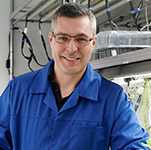Green factories for high value products
Identifying new medicines, renewable bioenergy and enhancing the nutritional content of food by harnessing plant metabolism.
Plants are a rich and largely unexplored resource for high value products that have medicinal properties, improve the nutritional content of food, or provide renewable alternatives to current energy sources.
Peter Doerner

How does their environment influence plant growth?
The Plant Growth Lab aims to understand how plants regulate their growth to make the most of their environment. Using these insights, we are developing solutions to pressing problems in food security arising from the climate crisis. With a focus on the root-soil-microbiome interface we develop solutions for improved efficiency of nutrient use, particularly phosphate.
We also work on mitigation of the stress responses that ensue when resources are limiting, or conditions are adverse, which negatively affect growth. We use many technical approaches, including transcriptome sequencing, genetic, chemical genomics, molecular-physiologic, and biochemical methods to answer our questions and identify sustainable solutions for food security.
Stephen Fry

Biochemistry of the plant cell wall
We are interested in the plant cell wall because it serves important biological roles — dictating the cell’s shape and size, repulsing pathogens, mopping up toxic metal ions, and gluing cells to each other within a tissue, to name but a few.
In particular, the mechanism and control of cell wall ‘loosening’ is of interest, regulating germination, growth, fruit ripening and abscission (natural detachment of parts of a plant).
Lots is still unknown about plant cell walls! Current areas of interest include:
- Enzymic mechanisms, old and new, of wall modification.
- Non-enzymic mechanisms of wall modification: role of vitamin C and hydroxyl radicals, an important chemical species.
- Evolution of primary cell wall in plants and algae.
- Cell walls as biotechnological materials.
Our preferred research strategy is to trace the ‘life histories’ of cell wall biopolymers produced in the living cell.
Andrew Hudson

Plant development and evolution
I’m interested in plant development and how mutations, hybridisation (crossbreeding between genetically dissimilar parents to produce a hybrid ), and adaptation make different forms and new species.
Our research team uses mostly snapdragons (Antirrhinum species) because they are diverse in form and adapted to different extreme environments. They also hybridise with each other, making it possible to identify the genes underlying their differences using genetics and genomics methods. Genetics studies the function and composition of single genes, whereas genomics addresses all genes and their inter relationships to identify their combined influence on the organism.
We’re currently looking at two questions. The first is whether adaptations to alpine environments are passed between species by hybridisation, which may explain why alpine snapdragons have evolved quickly and more than once.
Alistair McCormick

Engineering Biology to harness the power of photosynthesis
Photosynthesis is nature's principal means of harnessing solar energy and carbon capture, and is one of the most essential biological processes for sustaining life on earth. Our group studies the fascinating world of photosynthetic organisms using an Engineering Biology approach, the next evolution of the field of Synthetic Biology that uses engineering principles to design and construct biological parts that can be readily incorporated into living organisms.
Our current work is focused on improving photosynthetic efficiencies in land plants and micro-algae and developing molecular tools for exploiting micro-algae to produce high value compounds such as food supplements and health products.
Attila Molnar

Harnessing the power of biological engineering
Understanding the principles of gene regulation and genome editing is paramount for the field of engineering biology. Engineering biology is the application of engineering principles to the design and fabrication of biological components and systems, from modifications of natural systems to new forms of artificial biology.
In our laboratory, we specialize in studying epigenetics—a mechanism that controls gene activity without altering the DNA sequence, and DNA repair.
We focus on both land plants and microalgae, utilizing and advancing genome editing tools and technologies. This knowledge underpins our efforts in crop improvement, spanning from the creation of virus resistance in plants, to the production of high-value compounds in microalgae, such as food supplements.

